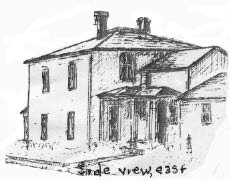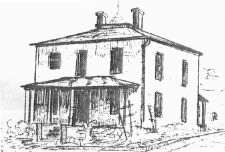
Discover rewarding casino experiences. 
|
It may be well to state that our political creed is of such a character that we still lean toward the glorious old Republican party. We do not believe it has fulfilled its mission or that it is necessary to kill the body politic because a few parasites have derived their sustenance from it ...” George Hay wrote in part in a long column in the Gazette in the take over of the newspaper in 1875, explaining in part how he would guide it. Subsequently, it appeared that Hay would be as much a part of the frequent “transfers” that had become almost a “traditiion” as the time Howlett had moved his offices. After only about eight months George Hay took on a partner, William Lowis, a Freeport printer. (That’s Lowis with an O, not Lewis with an E.) Because of Lowis’ experience Hay must have felt at ease leaving the newspaper in his hands because he went off to Kansas to look over possible land investments about which he wrote back home his opinions and times on the “frontier.” Most travelers did this. There was the same theme in all letters then ... The dreaded GH, as they were called, plagues of grasshoppers. A.G. Moffett’s letter said this, “As thick as rain drops, darkening the sky as clouds ... They came in upon the cabbages, corn, melons and oats. Stayed all night, then took their ‘hash’ again in the morning and took off...” But still many from the “Northwest” left for the West to make a claim even if the plants were stripped bare! Hay made a trip back to his homeland, Scotland, which he hadn’t seen for twenty-five years. Back in the States he settled at Savanna where founded a bank and lived until his retirement (see last week).
Meanwhile, William Lowis had taken on a partner, FHB MacDowell who had worked for the “Chicago Tribune” and had been secretary for the Typographical Union. The two “modernized” the paper, changing its style and make-up but they, too, changed positions by Lowis going elsewhere and MacDowell guiding the “Gazette” alone after February 1878. That editor lasted until November of 1879 when Mac sold out to Lewis Plate and Arthur Clarke who had worked almost next door for the other printing establishment in town, the “Brethren at Work,” a publishing house that printed religious tracts, pamphlets, study books, etc. for the German Baptist Brethren of Dunkards. They had set up at the south end of the commercial district in the “Barndollar Building” or the “Auction Store,” later to be known familiarly as Zier’s Garage (121 S. Broad St.) It was thought to have been an off-shoot of the “Brethren Messenger” that was printed in Germantown, Pennsylvania by J.T. Meyers who also was one of the instigators along with J.H. Moore and M.M. Eshelman in founding the Lanark shop. Many “Pennsylvania Dutch” had migrated from the East to Northwest Illinois over the past decade to make an impact not only on the economy with their expertise in farming and practical investments, but in the religious life of the area. From the Arnold’s Grove Church (see PDQ Me) had drawn so many members that it had split into four congregations that influenced the spiritual life of every neighborhood. Their ideas spred into other places including Denmark when the local churches sent the first foreign missionary from their church, a milestone event that changed thinking, and ways to do things even though it was a small, rural church. Having a publishing house was just another project that made the Northwest a religious center in many ways. S.H. Bashor bought out an interest in the “Brethren at Work” in 1877 and, yes, it too moved—from Lanark to Mt. Morris in 1880. In the winter, assumedly, because the heavy equipment could be pulled by ox/horse power across the snow drifts more easily by sleds than otherwise stuck in the mud or dirt in the spring/summer. Its story we’d like to tell in future! Arthur Clarke assumed full control of the “Gazette” in June of 1879, June. His guidance did not receive the support it needed to keep it afloat so it was sold to F.F. Livermore who committed to a positive change the title of the paper from “Carroll County Gazette” to “Lanark Gazette” because he felt the town deserved to have it’s own name on the masthead. Thanks, F.F. Yes, this “book” we’re printing in the mode of a PDQ Me series has been fun in the research(?) from scarce and scattered items casually discovered over the years in the old files of the Gazettes and Mt. Carroll Mirror. John Howlett has been my “pet project” for ever so long and we’ve tried to set the record straight on his career (from the distance of a century and more) and correct the wrong information that’s been printed about sites and more sites. The material to correct the chronology has been taken directly from files of the Gazette itself. From geneaology records of Howlett’s great, great grandson, Wayne Bickley, who just sent more material (HooRah!) and several local advisors. Thanks to them for their interest. Indulge me, please. Howlett entered his “valedictory” in the Gazette issue of June 26th, 1875. A sentence said, “After a painful and protracted illness ...” He was in his 51st year and had been in journalism since he was 21, a wealth of experience indeed. The “Mirror” printed this in part following his death July 29, 1875, “He discharged his duties with fearlessness and ability to place the Carroll County Gazette among the leading newspapers in this district. In common with humanity, Mr. Howlett may have made mistakes, yet it must be admitted he built up the reputation of Lanark and the surrounding county. His temperment being of a positive character he was not able to disguise his opinion of men or things. For him we have cherished a strong personal regard and it is with deep regret we bid our old friend a last farewell.” John Howlett died July 29, 1875 and was given a meaningful funeral, it having the largest cortege of anyone to that date in Lanark. The previous couple months there’d been bits and notes in the papers telling of his decline, he dictating “news” for the columns because he was too weak to write. In May this header read “Rare Opportunity— ... Material is all new, location is the best in the state ... Only reason for this sale is the health of the editor ... Last ten months the editor has been undergoing medical treatment...” Following the death notice and the kind words of most other newspapers, we learn that not everyone was admiring of the late editor. In September of ‘75 this appeared in the “Christian Radical,” a sheet from Polo whose editor remarked, “He was a skeptic and reviler and the Masons buried him with infidels. There was a great display ... Saw a man who is anything but a Christian carrying a Bible. The Lutheran minister is in full regalia. He died as he lived without a minister visiting him ... Overthrow of the Mason’s... Etc.” The Gazette editor and her friends tried to keep this article away from Orpha Howlett but someone gave it to her and she insisted that it be printed in the Lanark paper so they would know who wrote it. The one-time Congregational Church minister, Rev. Coleman. Outraged letters followed its publication, one letter from a friend in Mt. Carroll. H.A. Mills, a banker, wrote in part “If Howlett was a skeptic, a reviler and a scoffer of religion it was just such a religion as prompts its followers to say, write and publish such as he was against...” Amidst this controversy a very unusual thing occurred; something quite against all the strict rules that governed Victorian era manners. The grieving period was a time the widow of a deceased was to wear black for a year at least, sometimes for the rest of her life. Only close friends or family visited her and only quiet conversation took place.. Orpha Zeurch Tuller Howlett was building a house!! But, perhaps, having lived with an individualistic character all those years, Orpha, too was an individual. August, 1875, weeks only after Howlett’s death it was announced in the paper that Mrs. Howlett has commenced erection of a fine dwelling house east of the residence of D.W. Dame. The main floor will be 28’x30’, two stories with an ell one and a half story Snyder and Raymer are putting it up.” Then in November, 1875 the Gazette reported, “Mrs. Howlett has moved into her new residence. I.L. Hamilton has moved into the building she occupied.” That notice partially answers where the family had lived since the destructive fire in 1872 ... “The building.” But what building? A shed? A commercial clapboard? A barn? We’ll never know but didn’t she deserve a comfortable house what with all the moving here and there, up and down, the office/print shop in the living room? No one condemned her, it seems. In April, 1876, a wide front porch was added to the house by the same carpenters. Son, Henry, visited from San Francisco, day to day living continued. In October, Orpha Howlett took a trip Back East to visit her family. She’d been at home caring for the ailing husband, it was about time she got away even though construction a house kept her in Lanark, too. When the fire destroyed the “old” house with files from “Banner” and “Gazette” there had been $5,000 worth of damage and only $1,800 worth of insurance (J.H. had been an insurance agent, remember!) It wouldn’t have been likely there was insurance money to cover the building of a house, would there?! Orpha Tuller Howlett, it is suggested, came from a comfortably well-off family so perhaps the house was the result of money from home. It mattered not. She’d gone on with her life. Tune in for the closing chapters of one of the trades that helped a small prairie town develop in the Northwest. The sketch here is of 127 E. Locust St. that was built for Orpha Howlett in 1875. The drawing is from a 1980 Lanark Museum calendar.
|





